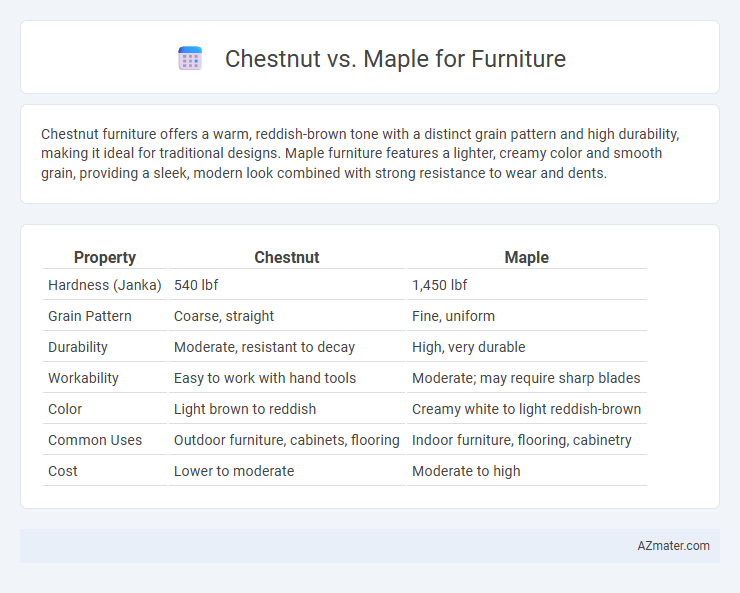Chestnut furniture offers a warm, reddish-brown tone with a distinct grain pattern and high durability, making it ideal for traditional designs. Maple furniture features a lighter, creamy color and smooth grain, providing a sleek, modern look combined with strong resistance to wear and dents.
Table of Comparison
| Property | Chestnut | Maple |
|---|---|---|
| Hardness (Janka) | 540 lbf | 1,450 lbf |
| Grain Pattern | Coarse, straight | Fine, uniform |
| Durability | Moderate, resistant to decay | High, very durable |
| Workability | Easy to work with hand tools | Moderate; may require sharp blades |
| Color | Light brown to reddish | Creamy white to light reddish-brown |
| Common Uses | Outdoor furniture, cabinets, flooring | Indoor furniture, flooring, cabinetry |
| Cost | Lower to moderate | Moderate to high |
Overview: Chestnut vs Maple Wood
Chestnut wood offers a coarse grain with warm, rich tones, making it ideal for rustic and traditional furniture designs, while maple wood features a fine, uniform grain and lighter color that suits contemporary and sleek aesthetics. Chestnut is moderately durable, resistant to decay, and tends to be lighter and more flexible, whereas maple provides exceptional hardness, strength, and resistance to abrasion, resulting in highly durable furniture pieces. Choosing between chestnut and maple depends on desired texture, color variation, and the furniture's functional requirements.
Appearance and Grain Patterns
Chestnut furniture showcases a warm, golden-brown hue with prominent, coarse grain patterns that create a rustic, textured look ideal for traditional or country-style interiors. Maple, on the other hand, features a lighter, creamy color with a fine, smooth, and consistent grain, offering a sleek and modern aesthetic that suits contemporary or minimalist designs. The distinct grain clarity in maple provides a subtle sophistication, while chestnut's bolder patterns emphasize natural character and aged charm.
Durability and Hardness Comparison
Chestnut wood offers moderate durability with a Janka hardness rating around 690, making it suitable for light to medium use furniture. Maple wood stands out with a higher Janka hardness rating between 1,450 and 1,500, providing exceptional resistance to dents and wear, ideal for high-traffic furniture pieces. The superior hardness and durability of maple make it a preferred choice over chestnut for long-lasting, heavy-use applications.
Workability in Furniture Making
Chestnut wood offers excellent workability with its straight grain and moderate density, making it easy to cut, shape, and finish for furniture projects. Maple, known for its hardness and fine, even texture, requires sharper tools but provides a smooth surface ideal for detailed carving and sanding. Both woods excel in durability, but chestnut's slightly softer nature allows for quicker handling, while maple's strength yields a long-lasting, robust furniture piece.
Finishing and Staining Qualities
Chestnut offers a coarse, open grain that readily accepts stains and finishes, resulting in a rich, rustic appearance ideal for traditional furniture. Maple has a tight, fine grain with a smooth surface that takes stain evenly but tends to highlight blotchiness without proper conditioning. Both woods finish well, but chestnut's porous texture provides deeper stain absorption, while maple requires careful preparation to ensure uniform stain application.
Resistance to Pests and Decay
Chestnut offers superior resistance to pests and decay due to its high tannin content, making it ideal for durable furniture in humid environments. Maple, while harder and more wear-resistant, is more susceptible to insect damage and decay without proper treatment. Choosing chestnut ensures longevity and natural pest protection, particularly for outdoor or rustic furniture pieces.
Availability and Sustainability
Chestnut furniture is less common due to the tree's declining population and slower growth, making it a rarer choice compared to maple. Maple wood, widely available in North America, is harvested sustainably from managed forests, ensuring a steady supply with minimal environmental impact. Sustainability ratings favor maple for its rapid growth and renewable qualities, while chestnut is often sourced from reclaimed wood to address ecological concerns.
Cost Differences in Furniture Projects
Chestnut furniture typically costs more than maple due to its rarity and rich grain patterns, which add a premium to its value. Maple is more widely available and easier to work with, making it a cost-effective choice for large-scale furniture projects. Project budgets often favor maple for its durability and affordability without sacrificing quality or appearance.
Popular Uses in Furniture Design
Chestnut is valued in furniture design for its durability and distinctive grain, making it popular for rustic and traditional pieces such as cabinets and tables. Maple's fine, consistent texture and strength make it ideal for contemporary furniture, including dressers and chairs, offering a smooth finish that accepts stains well. Both woods are favored for their workability and aesthetic appeal, with chestnut often chosen for visible, decorative elements and maple for structural components requiring resilience.
Choosing the Right Wood for Your Furniture
Chestnut offers a unique combination of durability and a warm, rustic aesthetic with its rich grain patterns, making it ideal for sturdy furniture pieces that showcase natural character. Maple provides a hard, dense surface with a smooth, fine grain, favored for modern and elegant furniture designs requiring high resistance to dents and scratches. Choosing between chestnut and maple depends on desired durability, grain appearance, and whether the furniture aims for traditional warmth or sleek refinement.

Infographic: Chestnut vs Maple for Furniture
 azmater.com
azmater.com